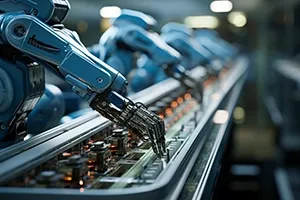Ron Schmelzer2025-01-09 10:41:47Forbes

The use of AI is bringing a wide range of innovations to the manufacturing industry that not only improves the quality and availability of goods, but also the ability to bolster manufacturing efforts in regions where AI can augment otherwise high cost of labor or availability of materials.
AI is Improving and Augmenting the Manufacturing Process
For a long time automation has been used in the process of assembling and manufacturing products, especially since the Industrial Revolution and the Industry 2.0 and 3.0 waves that increasingly added factory lines, computer-driven automation, and more precision fabrication technologies. AI is adding to this automation formula by adding aspects of intelligence that makes these automated manufacturing processes more accurate and adaptable.
Even though most of today’s traditional industrial robots lack the basic intelligence to qualify as AI, AI-powered robots are poised to make a substantial impact in the manufacturing industry. You can have non-intelligent robots that are programmed to do specific tasks and automate it, and those robots are usually caged off from humans due to the damage they could cause if you’re in the wrong place at the wrong time.
However, collaborative robots, also known as “cobots”, are a different sort of robotic beast. These AI-driven robots are being used for automating repetitive tasks, such as assembly or welding, or even materials handling. These collaborative robots are able to work side by side with humans, and so they don't need to be caged off.
The use of AI-powered computer vision solutions is also commonly applied to assist with quality control and inspection. Computer vision systems are being deployed to help spot defects in products throughout the manufacturing process. These systems can detect even the smallest of imperfections throughout the process, so that defective products can be removed from the production line and get fixed or scrapped before they get into customer's hands.
AI is helping move the manufacturing industry closer to the idea of the smart factory and the concept of Industry 4.0, in which machines, sensors, and systems are interconnected and communicate with each other. These interconnected systems collect data in real-time to optimize production processes, enhance decision-making, and enable predictive maintenance.
Furthermore, these fully automated and intelligent systems can be operated with minimal human intervention, allowing the idea of the “lights out factory” in which manufacturing systems can happen even while the lights are off.
In this vision, manufacturing systems operate around the clock, and you only need lights to be turned on when you're doing quality control. It's still more of a futuristic fantasy vision as it's very hard to take the human entirely out of the manufacturing loop, but you could see that technology is increasingly making its way in to automate those things.
AI is helping to make manufacturing processes more reliable, efficient, cost effective, and repeatable, giving factories more uptime, driving down the cost of goods, and reducing issues relating to labor shortages and staffing challenges. The smart factory can’t be realized without AI, since it takes intelligence to be smart.
AI is Keeping Manufacturing Running Efficiently and Effectively
Manufacturing companies are also using AI to keep the production line humming by keeping the equipment and tools running. AI analyzes data from sensors embedded in machinery to predict when equipment is likely to fail. This allows maintenance to be performed only when necessary, reducing equipment downtime and maintenance costs because if there's equipment downtime, the production line grinds to a halt.
AI is capable of analyzing all equipment data to know in advance when a machine might be heading towards failure. In anticipation of future potential failure, those machines may be able to be taken offline at a convenient time to perform predictive maintenance.
AI is also helping to keep manufacturing processes running by optimizing supply chain management by predicting demand, optimizing inventory levels, and improving logistics. Companies use AI to analyze vast amounts of data from suppliers, weather patterns, and market trends to enhance supply chain efficiency. With the help of AI, organizations are able to more effectively predict demand and optimize inventory levels, improve overall logistics as well.
Furthermore, AI is making manufacturing more efficient by optimizing production schedules by analyzing data, including order volumes, machine availability, and workforce capacity. This helps manufacturers maximize efficiency and minimize bottlenecks.
To keep energy-intensive production costs low, AI is even being used to monitor and optimize energy consumption in manufacturing facilities. AI systems analyze data from energy meters and production equipment to identify inefficiencies and suggest ways to reduce energy usage, leading to cost savings and more efficient and environmentally-friendly use of energy.
Assistance With Product Development and Design
AI is increasingly being used in the design process itself. Whether it's the design of a product or packaging, or improving overall product effectiveness, usability, reliability, or efficiency, AI is being used increasingly to accelerate the product design and prototyping. AI systems can analyze thousands of different alternatives and options, and identify desirable characteristics, factoring in cost, manufacturability, supply availability, energy usage, and other considerations.
These AI systems consider millions of different options with millions of different parameters and considerations, and help manufacturing firms design more efficiently, and more effectively deliver products to market.
As part of this process, organizations are employing AI to improve demand forecasting accuracy by analyzing historical sales data, market trends, and external factors such as economic indicators. This helps manufacturers better plan their production and inventory, reducing the risk of overproduction or stock-outs. These AI-powered forecasting systems can help anticipate demand and avoid supply chain or inventory disruptions that cause significant problems across the economy.
In all these ways, AI is making a significant impact on manufacturing today, and will no doubt power advancements in product design, development, production, and beyond in the manufacturing firm of the future.
Declare:The sources of contents are from Internet,Please『 Contact Us 』 immediately if any infringement caused